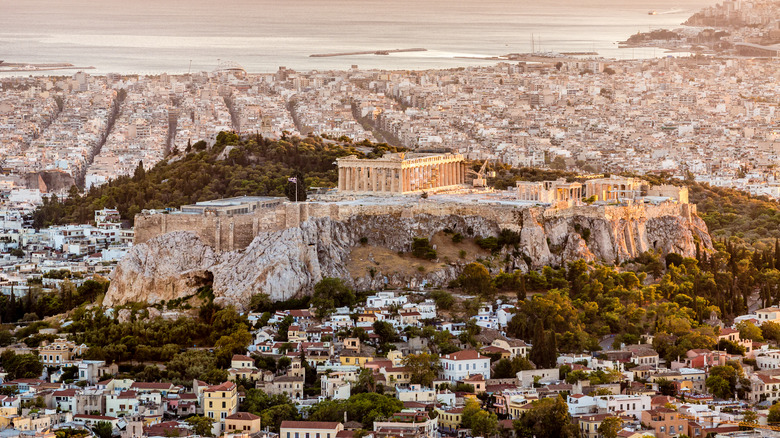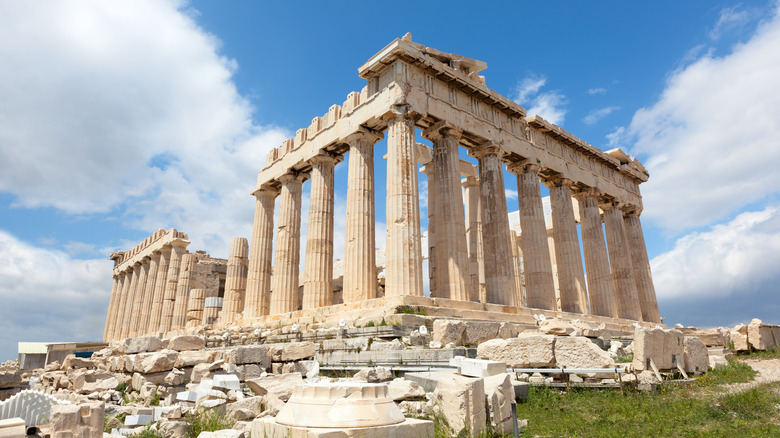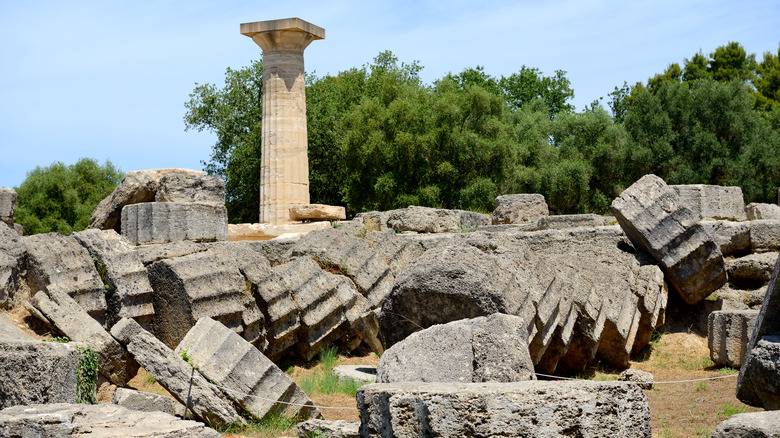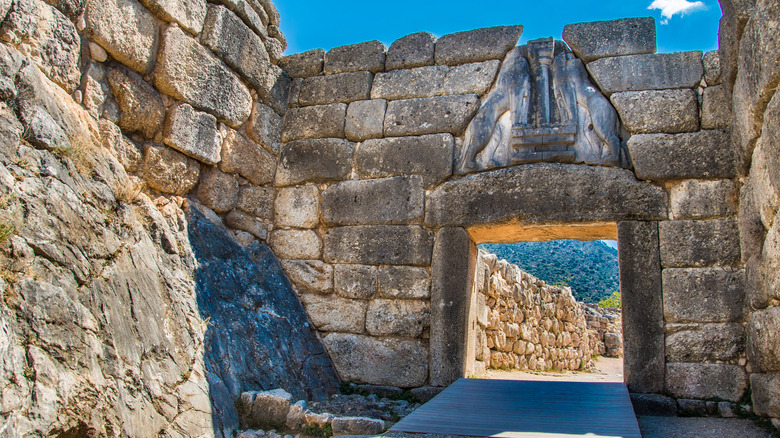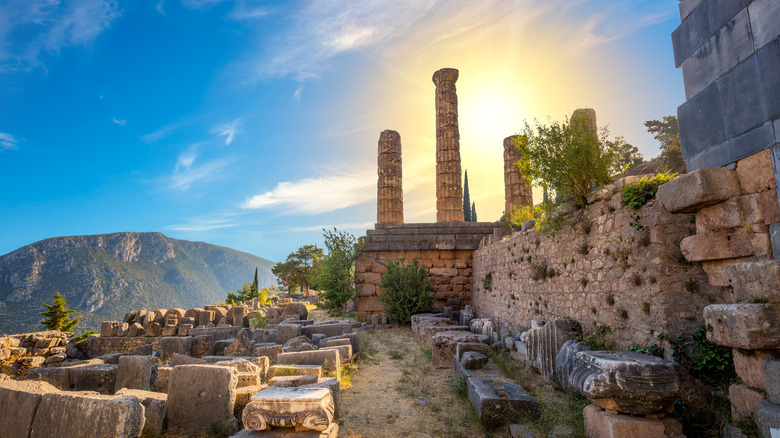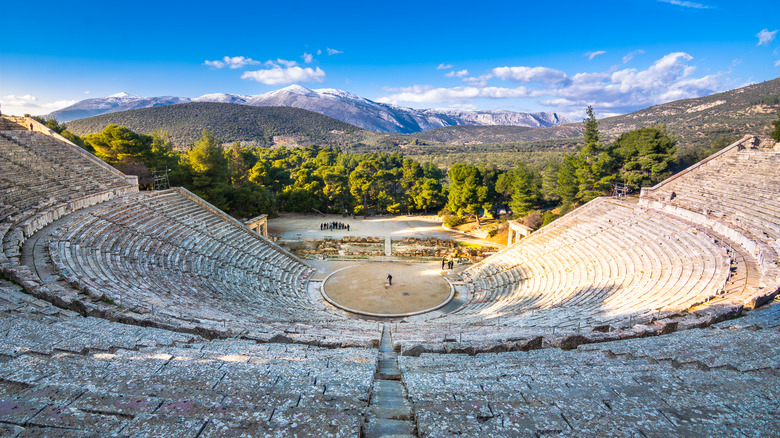Destinations One Of The World's First-Ever Travel Writers Wanted Everyone To Visit
When planning a vacation, many of us consult travel guides. These writings give us the finer points about a location, details we need to know before we go, and sometimes, valuable information about the culture and the locals we're about to visit.
If you're on the younger side, you may look up travel destinations on the Internet. If you're older, perhaps you have fond memories of carrying around a Lonely Planet book with information about your destination. The tradition of travel guides is probably much older than you think, however. One of the first travel writers actually published his book, "Periegesis Hellados," a very long time ago. In fact, historians believe he began working on it around 150 C.E. The title means "Description of Greece," and it was written by Pausanias, who lived from around 115 C.E. through 180 C.E.
Pausanias was born in the Asia Minor province of Lydia and traveled extensively. He not only wrote about the things you need to see when you visit, but he also gave advice to travelers and information about the locals and their customs. Unlike another Greek author, Herodotus, sometimes called the "Father of Lies," Pausanias is considered by historians to be pretty accurate, giving us contemporary descriptions of some incredible places. Let's take a look at some of the spots in Greece Pausanias thought we should visit and what's there today.
The Acropolis in Athens
Pausanias split his book up into 10 sections, talking about areas of Greece that the travel writer thought people should see. Though we can't get to all of them, here are some of the major ones you can visit almost two millennia later. The first site Pausanias described to readers is the Acropolis in Athens and the Parthenon that sits atop it. Obviously, you can visit Athens now, and it wouldn't be complete without a trip to these ruins.
Back then, the Parthenon had a statue of Athena, the goddess of wisdom and battle, that has since been lost to us. Pausanias said of this monument (via Thenoi), "The statue of Athena is upright, with a tunic reaching to the feet, and on her breast the head of Medusa is worked in ivory. She holds a statue of Victory about four cubits high, and in the other hand a spear; at her feet lies a shield, and near the spear is a serpent."
Another thing Pausanias spoke about was the culture and myths of the place he was visiting. He mentioned that the city of Athens and Athena's patronage of it came from a battle between her and the sea god Poseidon. In fact, he spoke of their contest and how it's depicted on the back of the statue's rear pediment. There are pieces of this pediment in the Acropolis Museum today, with other pieces in the British Museum as part of the Elgin collection, though Pausanias got to see it in full glory.
Temple of Zeus in Olympia
If you're planning on watching the 2024 Paris Olympic games, you're part of a tradition that started in 776 B.C.E. The Olympics began in Olympia, part of the region of Elis, where a great temple to Zeus was erected around 470 B.C.E. In this temple, Pausanias saw the giant statue of Zeus, the father of the gods, created by the famous sculptor Phidias.
Pausanias's description (via Grecoroman Library) begins, "The god sits on a throne, and he is made of gold and ivory. On his head lies a garland which is a copy of olive shoots. In his right hand, he carries a Victory, which, like the statue, is of ivory and gold; she wears a ribbon and — on her head — a garland. In the left hand of the god is a scepter, ornamented with every kind of metal, and the bird sitting on the scepter is the eagle." He also mentions golden sandals and robes, a bejeweled throne with ivory, gold, and ebony, and painted figures, including four Victories. He also praised the fervent Greek worship of Zeus and the gods in general.
The temple and statue were sadly destroyed around 426 C.E. These days, you can see the ruins of the temple of Zeus in modern Elis with a line of columns still standing, which you are allowed to walk around.
The ruins of Mycanae
The Trojan War, written about by the poet Homer, was supposed to have occurred around 1100 or 1300 B.C.E., so it was ancient history to Pausanias when he visited Mycenae in Argolis. Pausanias toured and wrote about what was supposed to be the graves of Trojan war hero Agamemnon, and his wife and ultimate murderer, Clytemnestra. He also mentioned the gate you see in the picture above, which was in ruins even then. He said (via Theoi), "There still remain, however, parts of the city wall, including the gate, upon which stand lions. These, too, are said to be the work of the Cyclopes [one-eyed giants], who made for Proetus the wall at Tiryns." If you look closely, you can still see the lions there today.
You can currently check out the Treasury of Atreus, where Pausanias believed that Agamemnon and some of his comrades from Troy were buried. You can also visit the Tomb of Clytemnestra, though it's likely it's the burial chamber of another queen or high-ranking woman. Pausanias mentioned that her grave was near that of Agamemnon, as well as those of their daughter, Electra, and son, Orestes. Oh, and the gate (and other creations in Mycenae) being the work of the Cyclopes? You can still look at what is called the Cyclopean Wall at Mycenae.
The oracle at Delphi
Pausanias said (via Academic.oup), "Many and different are the stories told about Delphi, and even more so about the oracle of Apollo. For they say that in the earliest times, the oracular seat belonged to Earth, who appointed as prophetess at it Daphnis, one of the nymphs of the mountain." Pausanias was speaking here about Delphi, the site of the Temple of Apollo, and the god's oracular priestess who was said to tell the future. He even mentioned what some believe was the source of her prophecy — vapors being emitted from the ground. Pausanias observed (via Perseus.tufts), "I have heard too that shepherds feeding their flocks came upon the oracle, were inspired by the vapors, and prophesied as the mouthpiece of Apollo."
Though there are only ruins of the Temple of Apollo at Delphi, you can actually visit this site that Pausanias mentioned, as well as the Sanctuary of Athena Pronaia, which protects Apollo's temple, and the theater of Delphi which is an open-air amphitheater.
Theater at Epidaurus
Speaking of theaters, they have a long history, with our earliest-known play performances happening in the fifth century B.C.E. in Greece. Pausanias himself wrote about several theaters in antiquity, including the Theater of Epidaurus, near Corinth, which can still be visited today. This outdoor amphitheater, part of complex of the Sanctuary of Asklepios, is one of the most intact of the ancient theaters of Greece. Pausanias said (via wol.jw) of the theater, "...there is the most remarkable theater of the ancient world. Although Roman theaters are more magnificent and imperial, no architect can compete with the beauty and the harmony of the Epidaurus theater."
The Theater of Epidaurus was, according to Pausanias, built around 340 B.C.E. by Polykleitos the Younger, though it was lost to the world for centuries after. He also wrote about the looks and symmetry of the structure. In fact, the writings of Pausanias about the Epidaurus Theater are what led 19th-century Greek archeologist Panagís Kavadías to the area where the theater was rediscovered. If you visit today, you can even see a live performance there during the Epidaurus Festival from the end of June through August.
